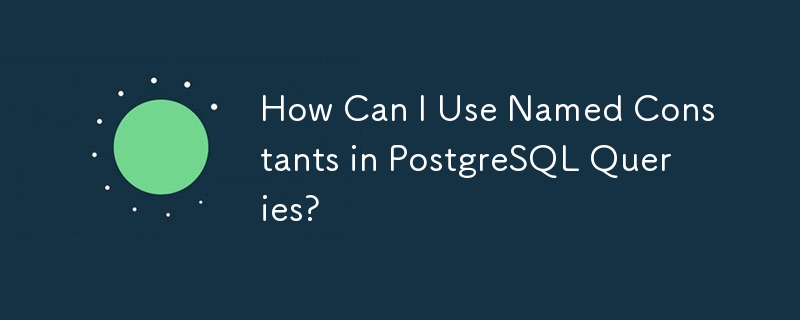How Can I Use Named Constants in PostgreSQL Queries?
Jan 08, 2025 pm 12:21 PM
Simulating Named Constants in PostgreSQL Queries with CTEs
PostgreSQL doesn't offer built-in named constants within queries. However, we can effectively achieve this using Common Table Expressions (CTEs).
Creating a Constant CTE
A CTE, named const for example, can be defined to hold our constant values:
WITH const AS (
SELECT 1 AS val
)Integrating the Constant CTE into Queries
This CTE is then joined with your main query using a CROSS JOIN:
SELECT ... FROM const CROSS JOIN <your_tables>
Illustrative Example
Let's say we need a constant MY_ID with the value 5. The query would look like this:
WITH const AS (
SELECT 5 AS val
)
SELECT *
FROM users
WHERE id = (SELECT val FROM const);Advantages of this Method
This approach offers several benefits:
- Reusability: The constant value is defined once and can be reused multiple times within the query without repetition.
- Readability: Queries become cleaner and easier to understand, particularly those with intricate constant expressions.
- Consistency: The constant value remains consistent across all query levels, including subqueries and joins.
This technique provides a practical workaround for the lack of direct named constant support in PostgreSQL queries.
The above is the detailed content of How Can I Use Named Constants in PostgreSQL Queries?. For more information, please follow other related articles on the PHP Chinese website!

Hot Article

Hot tools Tags

Hot Article

Hot Article Tags

Notepad++7.3.1
Easy-to-use and free code editor

SublimeText3 Chinese version
Chinese version, very easy to use

Zend Studio 13.0.1
Powerful PHP integrated development environment

Dreamweaver CS6
Visual web development tools

SublimeText3 Mac version
God-level code editing software (SublimeText3)

Hot Topics
 Reduce the use of MySQL memory in Docker
Mar 04, 2025 pm 03:52 PM
Reduce the use of MySQL memory in Docker
Mar 04, 2025 pm 03:52 PM
Reduce the use of MySQL memory in Docker
 How do you alter a table in MySQL using the ALTER TABLE statement?
Mar 19, 2025 pm 03:51 PM
How do you alter a table in MySQL using the ALTER TABLE statement?
Mar 19, 2025 pm 03:51 PM
How do you alter a table in MySQL using the ALTER TABLE statement?
 How to solve the problem of mysql cannot open shared library
Mar 04, 2025 pm 04:01 PM
How to solve the problem of mysql cannot open shared library
Mar 04, 2025 pm 04:01 PM
How to solve the problem of mysql cannot open shared library
 What is SQLite? Comprehensive overview
Mar 04, 2025 pm 03:55 PM
What is SQLite? Comprehensive overview
Mar 04, 2025 pm 03:55 PM
What is SQLite? Comprehensive overview
 Run MySQl in Linux (with/without podman container with phpmyadmin)
Mar 04, 2025 pm 03:54 PM
Run MySQl in Linux (with/without podman container with phpmyadmin)
Mar 04, 2025 pm 03:54 PM
Run MySQl in Linux (with/without podman container with phpmyadmin)
 Running multiple MySQL versions on MacOS: A step-by-step guide
Mar 04, 2025 pm 03:49 PM
Running multiple MySQL versions on MacOS: A step-by-step guide
Mar 04, 2025 pm 03:49 PM
Running multiple MySQL versions on MacOS: A step-by-step guide
 What are some popular MySQL GUI tools (e.g., MySQL Workbench, phpMyAdmin)?
Mar 21, 2025 pm 06:28 PM
What are some popular MySQL GUI tools (e.g., MySQL Workbench, phpMyAdmin)?
Mar 21, 2025 pm 06:28 PM
What are some popular MySQL GUI tools (e.g., MySQL Workbench, phpMyAdmin)?
 How do I configure SSL/TLS encryption for MySQL connections?
Mar 18, 2025 pm 12:01 PM
How do I configure SSL/TLS encryption for MySQL connections?
Mar 18, 2025 pm 12:01 PM
How do I configure SSL/TLS encryption for MySQL connections?







